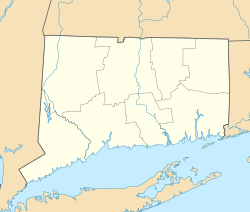Sterling Opera House facts for kids
Quick facts for kids |
|
|
Sterling Opera House
|
|

Sterling Opera House in 2009
|
|
| Location | 112 Elizabeth Street Derby, Connecticut |
|---|---|
| Built | 1889 |
| Architect | H. Edwards Ficken |
| Architectural style | Italianate |
| NRHP reference No. | 68000040 |
| Added to NRHP | November 8, 1968 |
The Sterling Opera House is a historic building in Derby, Connecticut. You can find it at 112 Elizabeth Street, right across from the Derby Green. This building is part of a special area called the Birmingham Green Historic District. This district has 10 buildings, including three churches and four monuments.
The Sterling Opera House was built in 1889. It became the very first building in Connecticut to be added to the National Register of Historic Places on November 8, 1968. When it first opened on April 2, 1889, it was more than just an opera house. It also served as the city hall and police station for Derby. After the entertainment part closed in 1945, the city continued to use it for government offices until 1965.
Contents
History of the Sterling Opera House
The Sterling Opera House first opened its doors to the public on April 2, 1889. It was designed by H. Edwards Ficken, an architect known for his Italianate Victorian style. He also helped design the famous Carnegie Hall in Manhattan, New York.
The building was made to serve both the city's government and its entertainment needs. The bottom two floors and the basement were used as the town's City Hall and police station until 1965. The main auditorium hosted hundreds of shows and live music performances. Many famous people, like Harry Houdini and Red Skelton, performed on its stage. Shows continued until 1945, when the curtain closed for the last time.
The Sterling Opera House was later recognized as a very important historic place. On November 8, 1968, it became the first building in Connecticut to be added to the National Register of Historic Places.
The very first show at the opera house was called "Drifting Apart" by James A. Herne. This play ended up causing some drama outside the building. At the time, the nearby town of Ansonia didn't think Derby needed another opera house. This disagreement helped lead to the two cities separating.
The last show at the Sterling Opera House was "Ye Olde Time Minstrel." It was put on by the Lafayette Men's and Women's Club. They held the show to honor soldiers returning from World War II. It ran from November 30 to December 1, 1945. After that, there were no regular shows for ten years. The building finally closed completely in 1965.
Inside the Opera House
The Sterling Opera House was built using a mix of architectural styles. This was done to appeal to a famous composer named Richard Swagner. The seats were set up so that everyone in the audience could see the stage clearly.
One architect worked on the lower levels and the outside of the building. Meanwhile, Ficken mainly focused on the roof, doorways, and inside walls. Another cool feature was the "piano boxes." These were special spots on each side of the stage. They were designed to hold two Sterling Pianos. The opera house is named after Charles Sterling, who also gave his name to the Sterling Piano Company.
Ghost Stories and Claims
The Sterling Opera House was even featured on a TV show called Ghost Hunters in 2011! Many people say they have seen strange things there. These include shadow figures, glowing orbs of light, and objects moving by themselves.
Even though no sad stories of deaths happened there, some believe the spirit of Charles Sterling, the man the building is named after, might still be around. People have also reported seeing and hearing a little boy playing with a soccer ball in the balcony seats. This spirit is supposedly named Andy. There are even soccer balls and other toys scattered around the building. People say these toys move from place to place and sometimes disappear! What was once a fun place is now known as one of the "spookiest" buildings in Connecticut.
Famous Performers
Many famous people performed at the Sterling Opera House over the years.
- Harry Houdini
- Amelia Earhart
- Lionel Barrymore
- John L. Sullivan, who played Simon Legree in a show of Uncle Tom's Cabin
The filmmaker D. W. Griffith also showed his movie The Birth of a Nation at the venue. Amelia Earhart visited the opera house on March 16, 1936. She was invited by the Women's Club and shared stories about her amazing flying adventures.
Future Plans
The Sterling Opera House has been empty for almost 50 years. It really needs to be fixed up. Peeling paint, broken windows, and rusted metal are just some of the problems that have gotten worse over time. The town of Derby wants to restore it as soon as possible.
In September 2011, the town government shared a plan to fix up the old Sterling Opera House. This plan is quite expensive, estimated to cost between 3 and 4 million dollars. U.S. Representative Rosa DeLauro helped get a grant for 150 thousand dollars to start cleaning the inside. Future plans include offering tours of the building. There is also a hope to make it the town's city hall once again.



